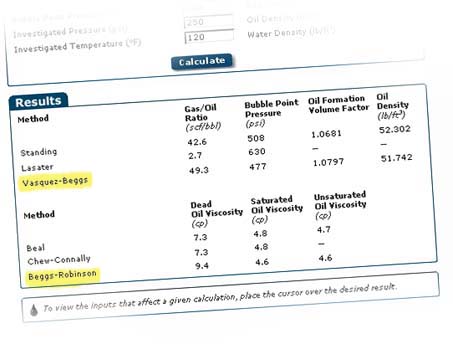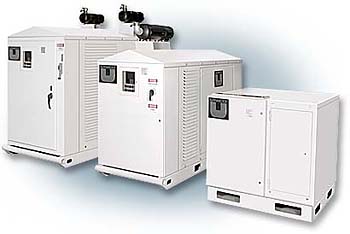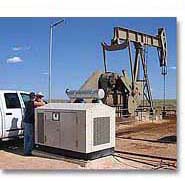
PRODUCT WATCH:
Line of Gas-Powered Artificial Lift Systems Expanded
Unico has expanded its line of intelligent generators designed specifically for the oil patch. The Gas-Powered Artificial Lift System (GPL), which combines both power source and advanced well automation
The GPL is specifically designed for continuous operation and offers an exceptional service interval and run life. Protective features and automatic restart capabilities allow the system to run
For more information on how the innovative GPL can help your operations, please contact us.
PERFORMANCE ANALYSIS TOOL:
Fuel Energy Analyzer
Unico's Fuel Energy Analyzer is an on-line tool for comparing the cost of operating an engine-driven generator using various fuels. The calculator compares liquid fuels, such as gasoline, diesel oil, and liquid propane, as well as gaseous propane and natural gas. Default fuel density and energy content numbers are provided, though they may be adjusted as needed. Once the fuel cost and consumption inputs are specified, the calculator determines the energy cost per kilowatt-hour, energy consumption in BTUs per kilowatt-hour, and energy efficiency for each fuel.
In Issue #6 of Solutions, we introduced a figure of merit for judging the overall electrical energy efficiency of artificial lift systems. A system that consumes 0.200 kWh or less per barrel of fluid per 1,000 feet of lift is reasonably efficient. Systems consuming more than 0.400 kWh could definitely use improvement.
Assuming an overall energy efficiency of an engine/generator system of 30% allows us to calculate the figures of merit for artificial lift systems for various fuels, as shown in the table below. While gasoline is not a normal fuel for pumping systems, it has been included for perspective.
|
Example Calculation Liquid propane consumption |
Fuel Consumption Benchmarks |
||
|
Energy Source
|
Fuel Consumption
Equivalent to 0.200 kWh per Barrel per 1,000 Feet |
Fuel Consumption
per Day of a 200 bpd 5,000 ft. Deep Well |
| Regular Gasoline |
0.0186 gal
|
18.6 gal
|
| Diesel Oil |
0.0169 gal
|
16.9 gal
|
| Liquid Propane |
0.0251 gal
|
25.1 gal
|
| Natural Gas |
2.2096 scf
|
2.21 Mcf
|
| Propane Gas |
0.9119 scf
|
0.91 Mcf
|
Visit www.unicous.com/oilgas/fuelcalc.php and try the Fuel Energy Analyzer for yourself.
Questions? If so, please contact us.
More Correlations Added to On-Line Calculator
The last two issues of Solutions have discussed the Correlations Calculator, a convenient online tool for predicting the gas content and viscosity of a well using basic field measurements and statistical relationships. Thus far we've presented the Standing, Beal, Lasater, and Chew-Connally methods. In this issue, we'd like to add the Vasquez-Beggs and Beggs-Robinson methods.
Vasquez-Beggs Correlation
The Vasquez-Beggs correlation, published in 1980, is widely used by industry and government agencies to estimate flash losses. M. Vasquez and H. D. Beggs studied more than 600 oil systems worldwide and considered approximately 6,000 measured data points, taken over a wide range of conditions, in developing their gas content predictions. The data encompassed the following range of parameters:
• Bubble-point pressures: 50 to 5,250 psia
• Reservoir temperature: 70° to 295° F
• Gas/oil ratio: 20 to 2,070 scf/stb
• API: 16° to 58°
• Gas gravity: 0.56 to 1.18
The Vasquez-Beggs method estimates the gas/oil ratio of natural gas (methane and higher molecular weight hydrocarbons) in standard cubic feet of liberated gas per barrel of oil. Methane emissions can then be estimated based on the fractional amount of methane in the flash gas.
Vasquez and Beggs found a strong correlation with the gravity of the evolved gas. Unfortunately, the accuracy of the gas gravity parameter is often questionable since it depends upon the pressure and temperature of the separators, which are frequently unknown. They found that the accuracy of the correlation was greater if the samples were divided into ranges of oil API gravity greater than and less than 30° API. The gas/oil ratio is determined from the oil API gravity and investigated pressure and temperature. The method tends to underestimate gas/oil ratio.
The Vasquez-Beggs approach is the most accurate yet in predicting bubble point pressure. The bubble point pressure and oil formation volume factor are estimated from the API gravity, gas/oil ratio, and investigated temperature. It shows agreement of –0.7% when applied to the original data set versus 3.8% for Lasater's and 4.8% for Standing's.
The equations also determine oil formation volume factor and oil density. The oil formation volume factor is estimated from the API gravity, gas/oil ratio, and investigated temperature. Oil density is determined from the API gravity, investigated temperature, gas/oil ratio, and oil formation volume factor.
Beggs-Robinson Correlation
H. D. Beggs and J. R. Robinson presented their method for determining both dead-oil and saturated-oil viscosities in 1975. The correlation was developed from more than 2,000 measurements on 600 oil systems. The range of data used was:
• Pressure: 0 to 5,250 psig
• Reservoir temperature: 70° to 295° F
• Gas/oil ratio: 20 to 2,070 scf/stb
• API: 16° to 58°
The Beggs-Robinson correlation estimates dead oil viscosity using the oil API gravity and investigted temperature. Saturated oil viscosity is determined from the dead oil viscosity and adjusted for the gas content using the gas/oil ratio. Gas/oil ratio can be estimated using the Vasquez-Beggs or a similar correlation. The unsaturated oil viscosity is estimated from the saturated oil viscosity, investigated pressure, and bubble point pressure.
The method reproduced the original measured data with an error of –1.8% and a standard deviation of 27%. Since the method consistently underestimates undersaturated viscosity, the method is frequently used to obtain a lower limit while other methods that overpredict can provide an upper limit.
Try the Correlations Calculator for yourself at www.unicous.com/oilgas/corrcalc.php. We will update the calculator as new methods are introduced in future issues of Solutions.
For more information, please contact us.
WHAT'S COMING UP:
In Future Issues...
Look for the following articles in upcoming issues of Oil & Gas Automation Solutions:
| Field tests of methods to eliminate rod pump gas locking and interference | |
| Reducing power consumption and improving power factor of beam pumps | |
| Using a torque economizer mode to improve efficiency and reduce gearbox stress | |
| Detecting stick/slip oscillations that fatigue rod-string couplings and reduce energy efficiency of PCPs | |
| Control options to ride through power disturbances |
Oil & Gas Automation Solutions is a publication of Unico, Inc. Copyright © 2005 Unico, Inc. All rights reserved.
All trade designations are provided without reference to the rights of their respective owners.
![]() Unico, Inc., 3725 Nicholson Rd., P. O. Box 0505, Franksville, WI 53126-0505
Unico, Inc., 3725 Nicholson Rd., P. O. Box 0505, Franksville, WI 53126-0505
262.886.5678 / 262.504.7396 fax
oilgas@unicous.com / unicous.com
 control in a convenient, fully integrated package, now ranges from 22 (30 hp) to 135 kW (180 hp).
control in a convenient, fully integrated package, now ranges from 22 (30 hp) to 135 kW (180 hp). unattended. The unit automatically switches between wellhead natural gas and liquid propane tank fuel sources. Optional wireless communication options allow continuous remote monitoring and control of pumping operations via a radio, cell phone, or satellite link.
unattended. The unit automatically switches between wellhead natural gas and liquid propane tank fuel sources. Optional wireless communication options allow continuous remote monitoring and control of pumping operations via a radio, cell phone, or satellite link.